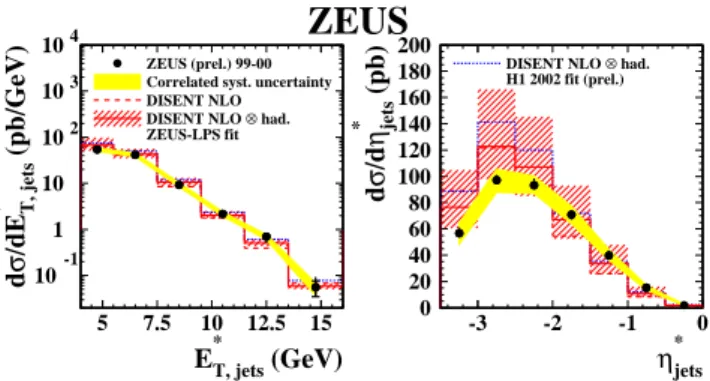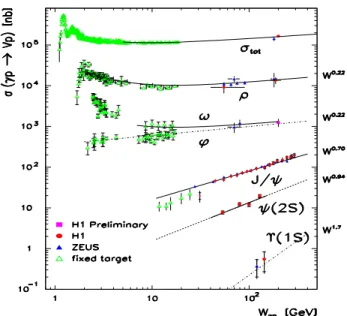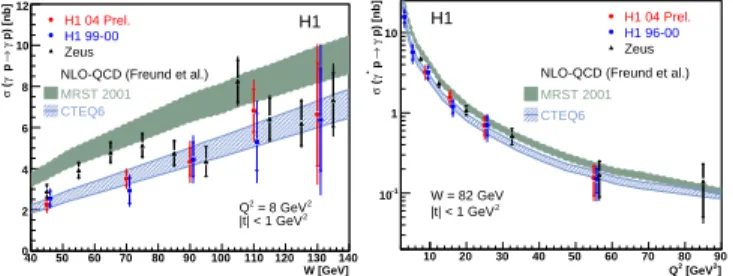Brazilian Journal of Physics, vol. 37, no. 2C, June, 2007 813
Exclusive Processes in Diffraction at HERA
A. Polini (on behalf of the H1 and ZEUS Collaborations) INFN Bologna, via Irnerio 46, 40126 Bologna, Italy
Received on 11 January, 2007; revised version received on 21 March, 2007
Recent results from the H1 and ZEUS experiments on exclusive processes in diffractive epcollisions at HERA are reviewed. The measurements discussed here include dijets and charm in photoproduction as well as in deep inelastic scattering. Such processes are sensitive to the partonic structure of the diffractive exchange, particularly to the gluon content, and represent complementary tests for the validity of QCD factorization in diffraction. The measurements are compared to theoretical models, including NLO predictions, using the most recent diffractive parton densities as extracted from inclusive measurements. Recent results on exclusive vector meson production and deeply virtual compton scattering are also presented.
Keywords: Diffraction; Charm; Deep inelastic scattering; Vector meson; DVCS
I. INTRODUCTION
In diffractivee±pprocesses at HERA, a photon of virtual-ityQ2from the incoming lepton interacts with a colour-singlet object within the proton, usually identified with the Pomeron. The final-state signature for such events is characterized by the presence of a large rapidity gap with no hadronic energy flow along the direction of the outgoing proton. The QCD factorization theorem[1] predicts that the cross sections for diffractive Deep Inelastic Scattering (DIS,Q2>1 GeV2) can be factorized into a set of universal diffractive Parton Density Functions (dPDFs) convoluted with process-dependent hard scattering coefficients, which can be calculated within pertur-bative QCD. Of particular interest are the measurements of open charm and of dijet photoproduction (Q2∼0) which pro-vide a direct probe of the gluon content of the Pomeron, and allow to perform complementary tests of the QCD factoriza-tion thanks to the presence of well-identified hard scales.
II. DIFFRACTIVE DIJET PRODUCTION
Diffractive dijet cross sections have been measured by H1 and ZEUS in DIS [2, 3] and photoproduction [2, 4].
Figure 1 shows the ZEUS measurement based on 65 pb−1 of DIS data (5<Q2<100 GeV2) with γ∗p center-of-mass energy in the range 100<W <250 GeV and the jets re-constructed using thekT algorithm in theγ∗pcenter-of-mass
system. The cross sections are compared to predictions from Next-to-Leading Order (NLO) QCD calculations using dPDFs extracted from inclusive diffractive DIS data [5, 6]. The good agreement observed in both shape and normaliza-tion between data and predicnormaliza-tions supports QCD factorizanormaliza-tion in DIS.
In photoproduction both H1 and ZEUS have observed the rate of dijet production uniformly suppressed by a factor of about 0.5 compared to the predictions. This is reminiscent of the observed breakdown of factorization in diffractive dijet production in pp¯collisions at the Tevatron [7]. Fig. 2 shows the distributions ofzIPandxγ, the reconstructed fraction of the momentum carried by the partons of the exchanged Pomeron and the photon, respectively, participating to the hard
scatter-ZEUS
10-1 1 10 102 103 104
5 7.5 10 12.5 15
E*T, jets (GeV)
d
σ
/dE
* T, jets
(pb/GeV)
ZEUS (prel.) 99-00 Correlated syst. uncertainty DISENT NLO DISENT NLO ⊗ had. ZEUS-LPS fit
0 20 40 60 80 100 120 140 160 180 200
-3 -2 -1 0
η* jets
d
σ
/d
η
* jets
(pb)
DISENT NLO ⊗ had. H1 2002 fit (prel.)
(pb) (pb)
FIG. 1: Comparison of the measured differential cross sections of di-jets in diffractive DIS as function of the jet transverse energyET∗, and the jet preudorapidityηwith three different NLO calculations avail-able. The inner (outer) error bands of the points show the statistical only (total) errors. The PDF uncertainties are not displayed.
H1 Diffractive
γ
p Dijets
H1 Preliminary correl. uncert.
H1 2002 fit (prel.) FR NLO*(1+δhad) RAPGAP
0 100 200 300 400 500 600 700 800
0.1 0.2 0.3 0.4 0.5 0.6 0.7 0.8 0.9 1
zIPjets
d
σ
/dz
IP
jets
(pb)
0 200 400 600 800 1000
0.1 0.2 0.3 0.4 0.5 0.6 0.7 0.8 0.9 1
xγjets
d
σ
/dx
γ
jets
(pb)
FIG. 2: Comparison of the measured differential cross sections of di-jet in diffractive photoproduction as function ofzIP,xγwith different NLO calculations. The inner (outer) error bands of the points show the statistical only (total) errors.
814 A. Polini
FIG. 3: Exclusive cross section as a function of theγ∗p center-of-mass energy for various vector mesons in photoproduction together with the total photoproduction cross section. The transitions in the slope from soft to hard scattering is clearly visible when moving from
γpscattering to light and heavy vector mesons production.
III. DIFFRACTIVE CHARM PRODUCTION
H1 has recently published measurements [8] of diffractive open charm production in DIS and photoproduction using an integrated luminosity of 42.6 pb−1. Two independent methods of charm reconstruction were used to extract the diffractive charm cross section. In the first, the charm quark is tagged by the reconstruction of aD∗(2010)meson. This technique is used in DIS and photoproduction. In the second, a method based on the displacement of tracks from the primary vertex is used to measure the open charm contribution to the inclusive diffractive cross section in DIS. A good agreement with the D∗measurement by ZEUS [9] and with NLO QCD calcula-tions is observed in the full kinematic regime, in favour of the validity of QCD factorization for open charm production both in diffractive DIS and photoproduction.
More precise mesurements and theoretical efforts are nec-essary to clarify the discrepancy observed between dijets and charm in photoproduction.
IV. EXCLUSIVE AND DIFFRATIVE VECTOR-MESON
PRODUCTION
The dynamics of diffractive interactions has also been ex-tensively studied through exclusive vector meson production e±+p−→e±+V+Y, whereV =ρ0,ω,J/ψ, ...andY is
ei-ther an elastically scattered proton or a low-mass state disso-ciative system. Fig.3 shows a collection of previous measure-ments of the exclusive vector meson production cross sections by H1 and ZEUS and fixed target experiments as a function of the center-of-mass energy W of theγ∗psystem. The photopro-duction of the light vector mesons (ρ0,ωandφ) is
character-] 2 t [GeV
-1.2 -1.0 -0.8 -0.6 -0.4 -0.2 -0.0 0.2
(t)
α
0.90 0.95 1.00 1.05 1.10 1.15 1.20
H1 PRELIMINARY
Photoproduction 0
ρ Elastic H1 ’05 Preliminary H1 ’05 fit Zeus ’95 Zeus ’95 fit Donnachie-Landshoff
(a)
ZEUS
0 10 20 30 40 50 60
20 40 60 80 100 120 140 160 180 200 W (GeV)
(
pJ
/
Y) (nb) BFKL LL (fixed s) BFKL LL + nonL (fixed s)
DGLAP LL
|t| (GeV2)
1-2
2-5
5-10 10-20
x 2 ZEUS (prel.) 96-00
(b)
FIG. 4: (a) The measurement by H1 of αIP(t) = 1.093±
0.003+0.008−0.007+ (0.116±0.027+0.036−0.046GeV−2)·t for elasticρ0 photo-production. (b) TheJ/ψcross section as function ofWas measured by ZEUS in four differenttbins. DGLAP and BFKL calculations are superimposed.
ized by a soft dependence of the cross sections as a function of W. This can be interpreted in the framework of Regge theory as due to the exchange of a Pomeron (IP) resulting in an en-ergy dependence of the form dσ/dt ∝ W4(αIP(t)−1), andα
IP(t)
similar to the soft pomeron model αIP(t) =αIP(0) +α′t ≃
1.08+0.25t, wheret is the square of the momentum trans-fer at the proton vertex.
Using a sample of more than 240000 events taken in 2005, H1 has performed a new measurement [10] of exclusiveρ0
photoproduction in the kinematic range 20<W<90 GeV and |t|<3 GeV2. From the measurement of theW dependence of this process in eight bins oft, theρ0 Pomeron trajectory
αIP(t)has been extracted for the first time from the data of a
single experiment. As shown in Fig.4a, the measurement is in good agreement with previous results and shows already a slope significantly smaller than the one of the soft Pomeron.
In the presence of a hard scale, like large values ofQ2,t, or the vector meson mass, perturbative QCD is expected to ap-ply. Diffractive vector meson production can then be seen in the proton rest frame as a sequence of three subprocesses well separated in time: the fluctuation of the exchanged photon into aqq¯pair, the hard interaction of theqq¯pair with the pro-ton via the exchange of (at least) two gluons in a color singlet state, and theqq¯pair recombination into a real vector meson. This approach results in a stronger rise of the cross section withW, which reflect the strong rise at small proton momen-tum fraction xof the gluon density in the proton. Further-more, to take into account the skewing effect, i.e. the differ-ence between the proton momentum fractions carried by the two exchanged gluons, one has to consider Generalized Parton Distributions (GPDs) which extend the definition of standard PDFs by including additional information on the correlations between partons and their transverse motion.
H1 has presented comprehensive results [11] on elasticJ/ψ
Brazilian Journal of Physics, vol. 37, no. 2C, June, 2007 815
W [GeV]
40 50 60 70 80 90 100 110 120 130140
p) [nb]
γ
→
p
*γ
(
σ
0 2 4 6 8 10 12
H1 04 Prel.
H1 99-00 Zeus
NLO-QCD (Freund et al.) MRST 2001 CTEQ6
H1
2
= 8 GeV
2
Q
2
|t| < 1 GeV
] 2 [GeV 2 Q
10 20 30 40 50 60 70 80 90
p) [nb]
γ
→
p
*
γ
(
σ
-1 10
1 10
H1 04 Prel.
H1 96-00 Zeus NLO-QCD (Freund et al.) MRST 2001 CTEQ6
H1
W = 82 GeV
2
|t| < 1 GeV
FIG. 5: New DVCS cross section as a function ofW andQ2as mea-sured by H1. Superimposed are previous results from H1 and ZEUS as well as NLO calculations based on GPDFs.
involved charm quark ensures the validity of a perturbative QCD description. This is even more so in DIS whereQ2can provide a second hard scale. TheQ2 andW dependent γ∗p cross-sections have been extracted. A steep rise with energy,
σ ∝Wδ, was observed with values ofδ≃0.75 independently ofQ2. The effective Pomeron trajectories have been extracted from the study of the doubly differential dσ/dt cross-section as a function ofW andt. In photoproduction, a positive value ofα′=0.164±0.028±0.030 GeV−2was obtained, leading to a shrinkage of the forward scattering peak, even if the effect is smaller than that observed in hadron-hadron interactions. In DIS, within its large error, the obtained value of α′ was found compatible both with the photoproduction result and with zero.
Photoproduction of vector mesons at large |t| is largely studied since a few years as it is expected to be described by perturbative models involving the BFKL dynamics. These models predict a power law behaviour of thet dependence of the cross section and a rise with|t|ofδof theWδ depen-dence. Proton-dissociative diffractive photoproduction ofJ/ψ
at highthas been measured by ZEUS [12] and the cross sec-tion as a funcsec-tion ofW andt. The data for |t|<M2J/ψare well described by a model based on DGLAP evolution. The cross section rises significantly with increasing energyW the higher|t|the stronger the rise. This behaviour is reproduced by BFKL but not DGLAP as seen in Fig. 4b.
V. DEEPLY VIRTUAL COMPTON SCATTERING
The simplest process sensitive to GPDs is Deeply Virtual Compton Scattering (DVCS), i.e. the hard diffractive
scatter-ing of a virtual photon off the protonγ∗p→γp at small|t| but largeQ2, which is fully calculable in perturbative QCD. A new high statistics analysis of DVCS has been performed by H1 [13] in the kinematic region 4<Q2<80 GeV2using data from 2004. Fig. 5 shows the cross section as a function ofW andQ2together with previous measurements from H1 [14] and ZEUS [15]. TheW dependence can be parametrized asσ ∝Wδ, yieldingδ∼=1.0 atQ2=8 GeV2, i.e. a value
in-dicating the presence of a hard scattering. The DVCS cross section has been measured differentially intand the observed fast decrease with|t|can be described by the forme−b|t|with b=6.02±0.35±0.39 GeV2atQ2=8 GeV2. This measure-ment allows to further constrain the models, as their normal-ization depends directly on thetslope parameter. NLO QCD calculations using a GPD parametrization based on the ordi-nary parton distributions in the DGLAP region and where the skewedness is dynamically generated provide a good descrip-tion of both theQ2and theW dependences.
VI. CONCLUSIONS
At HERA about 10% of the Deep Inelastic Scattering is diffractive. QCD fits have been performed and diffractive PDFs have been extracted. Measurements on exclusive dif-fractive processes are supporting the validity of QCD factor-ization in DIS. Results on diffractive dijet photoproduction disfavour factorization and leave room for theoretical and ex-perimental improvements and speculations. A wide spectrum of processes and their dependence on the available hard scales have been studied and show that the properties of the Pomeron exchange at the larger scales are consistent with those of a hard process. Recent measurements on deeply virtual comp-ton scattering and exclusive vector meson production from HERA are especially interesting because of their sensitivity to the Generalized Parton Densities. The rich physics program of HERA, aiming at a total of 500 pb−1by mid 2007, will help clarifying some of the ongoing issues and provide a use-ful input for the prediction of the diffractive exclusive cross sections at the LHC.
Acknowledgements
I would like to thank all the people involved in the con-ference preparation for the perfect organization and the warm atmosphere during the whole workshop.
[1] J. Collins, Phys. Rev. D57, 3051 (1998) and erratum ibid. D
61, 019902 (2000).
[2] O. Gutsche, presented at ICHEP 2004, H1-prelim-04-113. [3] M. Kapishin, presented at ICHEP 2006, ZEUS-prel-05-020. [4] M. Kapishin, presented at ICHEP 2006, ZEUS-prel-05-001. [5] H1 Collab., A. Aktaset al., preprint DESY 06-049, accepted by
Eur. Phys. J.C.
[6] ZEUS Collab., S. Chekanov et. al., Eur. Phys. J. C 38, 43 (2004).
[7] CDF Collab., T. Affolder et al., Phys. Rev. Lett. 84, 5043 (2000).
[8] H1 Collab., A. Aktaset al., preprint DESY 06-164, submitted to Eur. Phys. J.C.
[9] ZEUS Collab., S. Chekanovet. al., Nucl. Phys. B672, 3 (2003). [10] J. Olsson, presented at DIS 2006, H1 prelim. 06-011.


